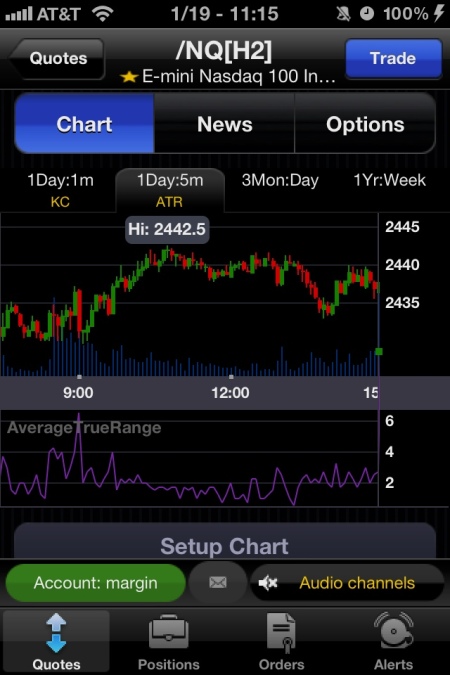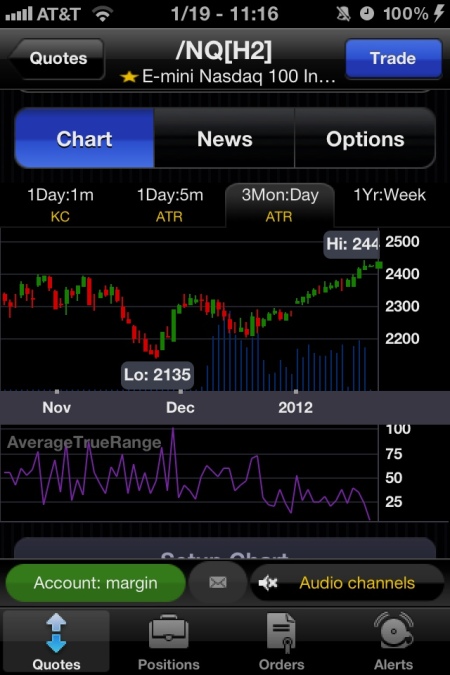Just 2 NQ points a day. That’s all I ask. Instead of trying to get every last tick out of a given move, I am content to consistently pull out a little bit, over and over. This is the intent of the strategy.
The strategy is based on these market attributes:
1. The index futures (NQ Nasdaq emini in my case) tend to back and fill a lot. One way trends are (relatively) rare. Important price levels are revisited over and over again.
2. Market prices tend to move. Price doesn’t hold still for long.
Two points and then quit for the day should be achievable almost all the time. I just want to make chip shots. Just be consistent and do it over and over.
On a 5 min NQ chart, around half of all the bars are wider than 2 points:
The average daily range for NQ lately is near 40:
A two point target is in the noise. But that’s the point: Instead of trying to drink every last drop of a passing river, I want to dip my cup in and just catch a little of what is flowing by. I don’t need to catch an entire wave. Just a little portion of it.
All this time as a loser, I have been trading in hopes of catching a big move. I might have a 5 point target and a 2 point stop. I was constantly setting myself up for failure. I would enter at the market and hope for a big move, ready to take the small loss if need be. That risk:reward might look attractive, but my stop was being hit nearly every time.
So I literally faded my strategy. I looked at the current market, and placed limit orders to fade moves roughly 3 points away from the current price. That put my entry at pretty much exactly where my stop loss would have been if I traded my old way. Once one of them hit and was filled, I set a disaster stop of 5 points (basically an arbitrary number at this point), and a profit limit order just two points away from my entry. Then I sat and waited. My profit target would be hit more than 80% of the time. If the market kept going against me, I waited for it to come back. I honored the disaster stop, but in the first 18 paper trades it was never hit. Most of the time, I could get out for break-even or just a small loss close to 2 points. That exit for a small occasional loss is exactly where my trailing stop for a profit usually was under my old strategy.
To avoid fading a strongly trending market and getting my disaster stop hit, I didn’t use this method near the open or market close. I avoided fading near the highs/lows of the day. I waited for the afternoon doldrums and tried when the market was listless, choppy and noisy, putting conditions in my favor.
Another positive element in this strategy is the very short time that I am exposed to the market. In some of the engineering applications I encounter in my work, a trade-off is made between accepting risk vs. having reduced performance. A probabilistic design method is employed. Instead of designing for the worst case failure mode at the worst possible time in all conditions, we look at the probabilities that these conditions may overlap. If the worst case failure only happens at very extreme conditions, and a vehicle only spends a tiny fraction of a percent of its service life at that condition, designing for this condition puts a large burden of weight and performance reduction for the entire class of vehicle across the whole service life. We can slim down the vehicle by only designing to a probabilistically acceptable failure condition. We still have to avoid a disaster, so we make sure any failure is not catastrophic by keeping enough margin in the system. We just allow a failure to cause an aborted mission or acceptable amounts of damage. Back to my trading: most of these trades last only a few minutes or so. While big adverse moves happen in the market, the odds that one of these moves come during the few short minutes that I am exposed to the market are very small. If I’m always in the market and holding positions, then the odds are high. But the shorter my exposure time, the smaller the probability of a big event becomes. Since the probability is not zero, I still have the disaster stop, just like in the vehicle design. LTCM didn’t have a disaster stop. They KNEW that it was statistically “impossible” that they would see the conditions that would blow them up. I am not naive like that. A non-zero probability is still possible. You have to prepare against it even though you will probably rarely see it.
The biggest weakness I see is if I end up fading a persistent trend. I’ve paper traded this strategy a bit, and on a strong trend day it’s easy to rack up two 10 point losses in a hurry. That wipes out a lot of winning trades. This strategy would be best used during choppy sideways markets. How to rigorously define that is not clear to me. I guess that’s where I often get hung up. I can’t know exactly if a move will turn out to be an adverse trend every time. I have to define a way that works much of the time an accept the few times it when it doesn’t. I want to take discretionary elements out for now. The book “Trading in the Zone” is helping me to think more probabilistically rather than in “right or wrong” terms.
So the idea is literally fading my old self to have a winning strategy. I’ll be doing some back testing with it soon. If you have any comments about this
approach, I’d love to hear them.




